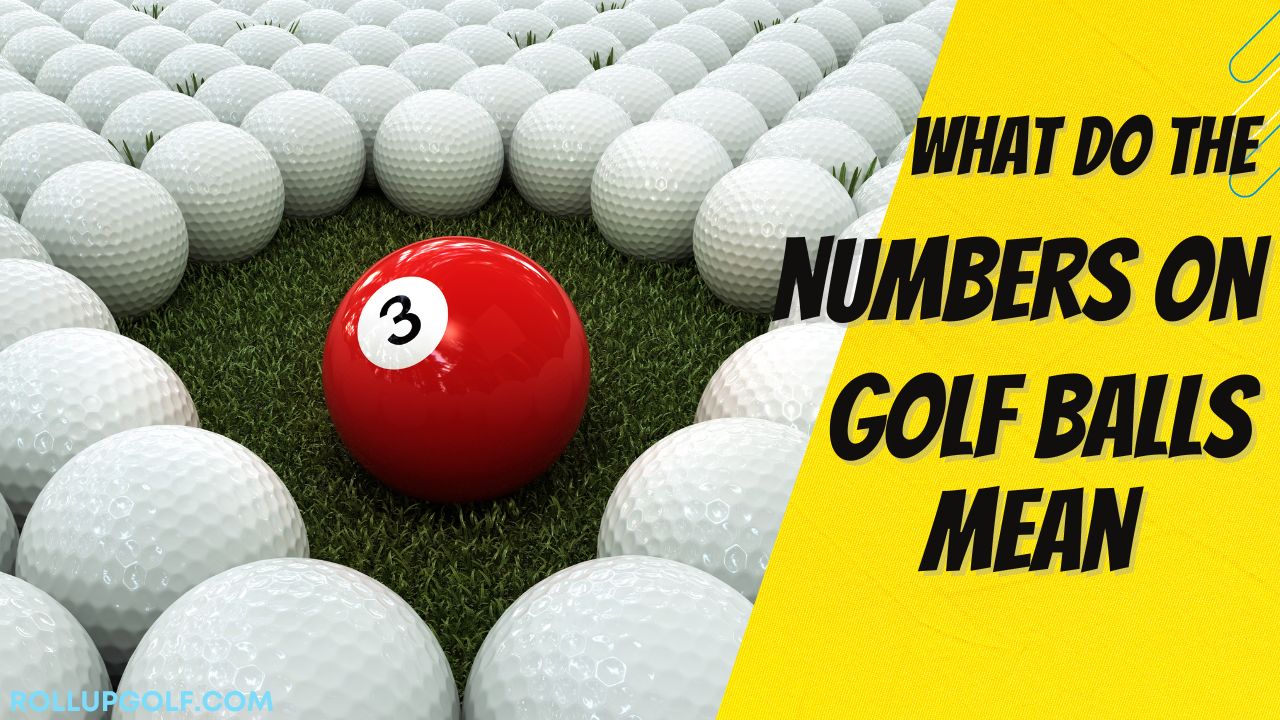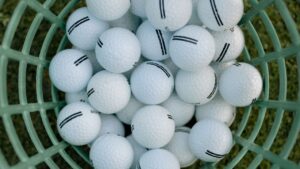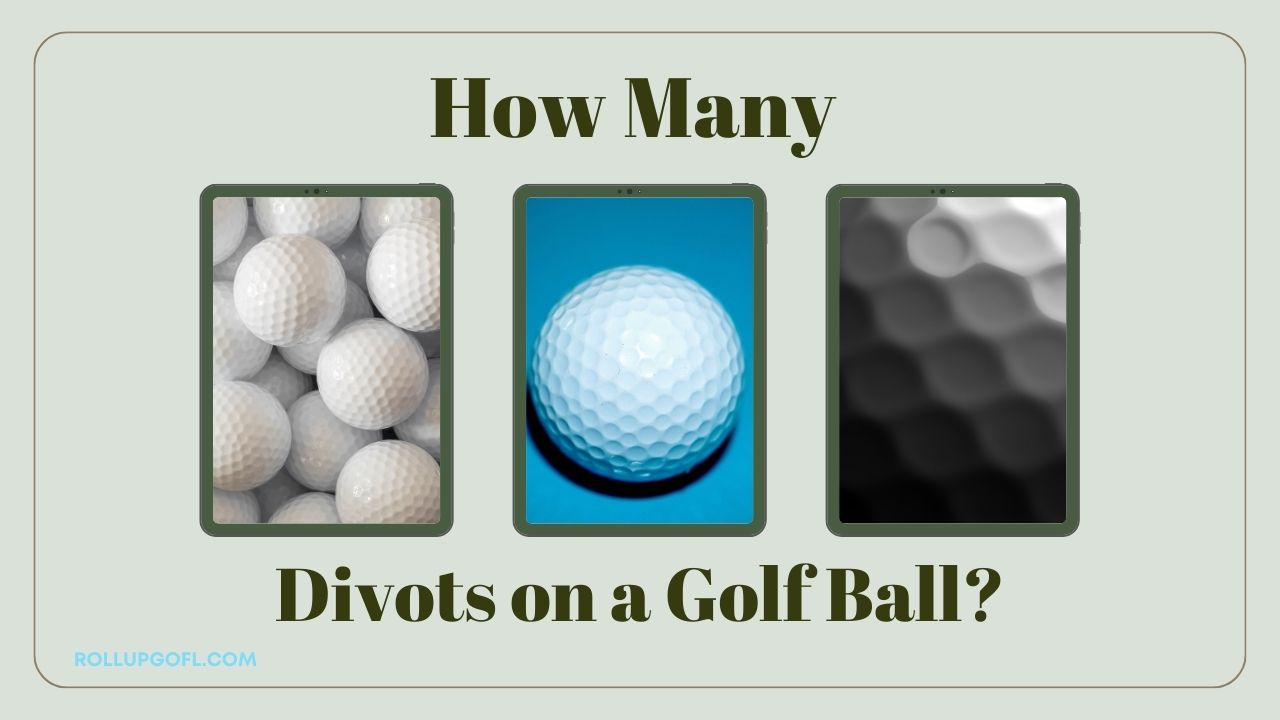
Golf is a sport of precision and detail, where even the smallest factors can make a significant difference in performance. Among these factors are the numbers printed on golf balls, which carry more significance than meets the eye. In this article, we’ll delve into the world of golf ball markings and decipher what these numbers mean.
What Do the Numbers on Golf Balls Mean?

The numbers you see on a golf ball can have two different meanings:
-
Identification: This is the most common meaning. It’s simply a single-digit number (usually 1-4, but sometimes higher) that helps golfers identify their ball among others, especially if they’re playing with the same brand of ball. For instance, if two people are playing Titleist balls, they might have a “Titleist 1” and “Titleist 3” to easily distinguish which ball belongs to whom.
-
Compression Rating (less common): In the past, some golf balls had a two-digit number printed on them. This number indicates the ball’s compression rating, which is a measure of how much the ball squishes at impact. A lower number (in the 70s or 80s) meant a softer ball, ideal for golfers with slower swing speeds. Conversely, a higher number (closer to 100) meant a firmer ball for golfers with faster swing speeds. However, compression rating is less emphasized these days, so you’re less likely to see this kind of marking on modern golf balls.
Read also: How to Reshaft a Golf Club?
why are golf balls numbered 1 to 4
The numbers 1 to 4 on golf balls are there for one key reason: identification.
Here’s why having these numbers is important
-
Multiple players, same brand: In a round of golf, it’s common for multiple players to use the same brand of ball. The numbers help differentiate whose ball is whose. Imagine two players using Titleist balls – one with a “Titleist 2” and another with a “Titleist 4.” During play, the numbers make it clear which ball belongs to whom.
-
Avoiding confusion: Even if golfers aren’t using the same ball (say, different models within the same brand), having numbered balls helps prevent confusion. Let’s say someone is playing a Callaway Chrome Soft and another a Callaway Tour Easy. If both lacked numbers, a stray shot landing near either ball might lead to momentary confusion about ownership.
While 1 to 4 are the most common numbers, some brands offer balls with numbers up to 9 or even allow for customization with double-digit numbers.
It’s important to note that these numbers typically don’t indicate anything about the ball’s performance or quality. They are purely for identification purposes. However, some golfers might add their markings alongside the number for further personalization.
what do high numbers on golf balls mean

High numbers on golf balls (typically 5, 6, 7, or 8) don’t have any special meaning in terms of performance. They still simply serve the purpose of identification, just like the standard 1-4.
Here’s the breakdown:
-
Standard Numbers (1-4): These are the most widely available and come in a pack with each sleeve containing balls with a different number (1, 2, 3, 4).
-
High Numbers (5-8): These are not as common as the standard numbers. You might find them sold separately or in packs where all the balls have the same high number. They are typically offered by manufacturers as a premium option for golfers who want something different or unique.
Here are some reasons why someone might choose a high number:
-
Standing Out: Some golfers, particularly those with a competitive personality, might prefer a non-standard number to differentiate their ball during a round.
-
Personalization: High numbers can be a way to personalize your balls, especially if you’re giving them as a gift.
-
Availability: In some cases, high numbers might be the only option available for a particular ball model.
Overall, high numbers on golf balls are simply an aesthetic or preference-based choice, and they don’t affect how the ball performs.
Read also: Are golf shirts business casual?
History of Golf Ball Markings
Golf ball markings have a rich history that dates back centuries, evolving from simple identification methods to sophisticated numbering systems. Understanding the evolution of golf ball markings provides insights into the development of the sport and the advancements in golf ball technology over time.
Early Beginnings
In the early days of golf, which can be traced back to 15th-century Scotland, golf balls were typically made of wood. These primitive balls were smooth and lacked any markings or distinguishing features. As the popularity of golf grew, there arose a need for a more reliable method of identifying individual balls, especially in group play.
Introduction of Markings
By the 17th century, golf balls began to feature rudimentary markings, often in the form of hand-painted designs or symbols. These markings served primarily as identifiers, allowing golfers to differentiate their balls from those of their fellow players. However, the markings varied widely in style and consistency, as they were applied manually and lacked standardization.
Evolution of Numbering Systems
The concept of numbering golf balls emerged in the late 19th and early 20th centuries as the sport became more organized and standardized. Manufacturers began to imprint numerical identifiers on golf balls to distinguish different models and variations. Initially, these numbers were simple and often represented a specific brand or model rather than indicating performance characteristics.
Standardization and Consistency
As golf grew in popularity and became more formalized, there arose a need for standardization in golf ball markings. Organizations such as the United States Golf Association (USGA) and The Royal and Ancient Golf Club of St Andrews (R&A) established guidelines and regulations governing the design and marking of golf balls.
This ensured consistency and fairness in competitive play while also providing consumers with clear information about the characteristics of each ball.
Modern Numbering Systems
In modern times, golf ball markings have become more sophisticated, with manufacturers using advanced printing techniques to imprint numbers, logos, and other identifiers on the surface of the ball. These numbers often indicate specific performance attributes such as compression, construction, and intended use. Golfers can now choose from a wide range of numbered balls tailored to their individual preferences and playing styles.
Innovations and Future Trends
Advancements in technology continue to drive innovation in golf ball design and markings. Manufacturers are constantly experimenting with new materials, constructions, and dimple patterns to optimize performance and enhance player experience. The future of golf ball markings may see further integration of digital technologies, such as embedded RFID chips or QR codes, to provide real-time feedback and analysis.
Read also: What Golf Ball Should I Use?
Deciphering Golf Ball Numbers
The numbers on golf balls typically range from one to four, although some may go higher. Each number represents a different characteristic of the ball, including its compression, construction, and intended use. For example, a lower number indicates a softer compression, while a higher number signifies a firmer feel.
Construction and Composition
Understanding the construction of golf balls is essential in deciphering their numbers. Modern golf balls are typically made with a core, mantle, and cover. The materials used and the number of layers determine the ball’s performance characteristics, such as distance, spin, and feel.
Compression and Spin
Compression and spin are two critical factors that affect how a golf ball performs in flight. The compression rating of a golf ball indicates how much the ball deforms upon impact with the clubface. Lower compression balls are softer and compress more, while higher compression balls are firmer and compress less. Spin, on the other hand, refers to the rotation of the ball as it travels through the air. Golf ball numbers influence both compression and spin rates, which in turn affect distance and control.
Dimples and Aerodynamics
The dimple pattern on a golf ball plays a crucial role in its aerodynamics. The number and arrangement of dimples impact the ball’s trajectory and stability in flight. Golf ball numbers can also affect aerodynamic performance, as certain designs are better suited for specific swing speeds and playing conditions.
Different Types of Golf Balls

Golf balls come in a variety of types, each designed to cater to different playing styles, skill levels, and course conditions. Understanding the characteristics of these various types can help golfers make informed decisions when selecting the right ball for their game.
1. Distance Golf Balls
Distance golf balls are engineered to maximize the distance a ball travels off the tee. These balls typically feature a low-compression core and a resilient cover, allowing for higher initial ball speeds and reduced spin. They are ideal for golfers with moderate to slow swing speeds who prioritize distance over control.
2. Tour Golf Balls
Tour golf balls are designed for professional and low-handic players who demand maximum performance and control. These balls often feature multi-layer construction with a soft urethane cover, providing an exceptional feel and spin around the greens. Tour balls have higher compression ratings and are suitable for golfers with fast swing speeds who prioritize precision and shot-shaping ability.
3. Low Compression Golf Balls
Low-compression golf balls are softer and more forgiving, making them suitable for beginners, seniors, and golfers with slower swing speeds. These balls compress more easily upon impact, resulting in higher launch angles and longer carry distances. Low-compression balls offer enhanced feel and control, making them an excellent choice for players seeking forgiveness and consistency.
4. High Compression Golf Balls
High-compression golf balls are designed for advanced players with fast swing speeds who require maximum distance and control. These balls feature a firmer core and cover, resulting in lower spin rates and greater ball speeds. High-compression balls are less forgiving than their low-compression counterparts but offer superior performance for skilled golfers seeking precision and shot-making versatility.
5. Multi-Layer Golf Balls
Multi-layer golf balls are constructed with multiple layers of varying materials, each optimized for specific performance characteristics. These balls offer a combination of distance, spin, and feel, making them suitable for a wide range of players. Multi-layer balls provide the versatility to perform well in various playing conditions, from windy days to soft or firm turf.
6. Soft Feel Golf Balls
Soft feel golf balls prioritize feel and feedback, providing a responsive sensation upon impact with the clubface. These balls typically feature a low-compression core and a thin, soft cover, resulting in a buttery feel and enhanced greenside spin. Soft feel balls are popular among recreational golfers who value touch and finesse around the greens.
7. Value Golf Balls
Value golf balls, often referred to as “lake balls” or “recycled balls,” are used balls that have been retrieved from water hazards or other areas on the course. While they may show signs of wear and tear, value balls offer an affordable option for budget-conscious golfers. They come in various brands and models, allowing players to experiment with different types of balls without breaking the bank.
8. Specialty Golf Balls
Specialty golf balls cater to specific niche markets or playing conditions. Examples include low-spin balls for windy conditions, high-visibility balls for low-light conditions, and extra-durable balls for rough terrain. Specialty balls may feature unique designs or materials tailored to address specific challenges or preferences faced by golfers.
Impact on Performance
Choosing the right golf ball can significantly impact your performance on the course. By understanding the numbers on golf balls, you can tailor your selection to match your playing style and preferences. Whether you’re looking for maximum distance off the tee or precise control around the greens, there’s a golf ball out there suited to your needs.
Common Misconceptions
Misconceptions about golf balls abound, often leading to confusion among players. By debunking these myths, golfers can make more informed decisions when selecting equipment and improve their overall performance on the course.
1. Higher-Numbered Balls Always Travel Farther
Contrary to popular belief, the numbers on golf balls do not directly correlate with distance. While some high-numbered balls may offer added distance for certain players, the choice between low and high-numbered balls depends on various factors such as swing speed, spin rate, and playing conditions.
2. All Golf Balls of the Same Model Are Identical
While golf ball manufacturers strive for consistency in their products, there can be slight variations from ball to ball within the same model. Factors such as manufacturing tolerances and quality control measures can result in subtle differences in performance characteristics. Golfers need to test and select individual balls that suit their preferences and playing styles.
3. Premium Golf Balls Are Only for Pros
Premium golf balls, often marketed as “tour-level” or “professional-grade,” are not exclusive to elite players. While these balls are designed to meet the demands of professionals and low-handicap golfers, recreational players can also benefit from their advanced performance features. Choosing the right ball based on personal preferences and needs is more important than skill level alone.
4. Golf Ball Compression-Only Affects Distance
Compression rating plays a significant role in determining how a golf ball performs, but its impact extends beyond distance. While lower compression balls may offer added distance for slower swing speeds, higher compression balls can provide better control and feel for faster swing speeds. Understanding how compression affects spin rates and launch angles is crucial for optimizing performance.
5. Golf Ball Numbers Do Not Matter for Putting
While golf ball numbers primarily influence distance and control off the tee, they can also affect putting performance. Different compression ratings and cover materials can influence the feel and roll of a golf ball on the putting green. Golfers should consider their preferences for firmness and responsiveness when selecting a ball for putting.
Choosing the Right Golf Ball
Choosing the right golf ball is crucial for optimizing performance and enhancing your overall experience on the course. With numerous options available, selecting the perfect ball can seem daunting. However, by considering key factors such as compression, spin, feel, and intended use, you can narrow down your choices and find the ball that suits your playing style and preferences.
1. Assess Your Skill Level
Before diving into the specifics of golf ball selection, it’s essential to assess your skill level and playing style. Are you a beginner looking for forgiveness and distance, or a seasoned player seeking precision and control? Understanding your strengths and weaknesses in the course will help guide your decision-making process.
2. Consider Swing Speed
Swing speed plays a crucial role in determining the type of golf ball that best suits your game. Players with slower swing speeds may benefit from low-compression balls, which compress more easily for added distance. Conversely, golfers with faster swing speeds may prefer higher compression balls for enhanced control and responsiveness.
3. Evaluate Compression
Compression refers to how much a golf ball deforms upon impact with the clubface. Low-compression balls are softer and compress more, making them ideal for players with slower swing speeds. High-compression balls, on the other hand, are firmer and compress less, providing greater control and feel for faster swing speeds. Consider your swing speed and desired performance characteristics when selecting the appropriate compression rating.
4. Analyze Spin Rates
Spin rates influence how a golf ball behaves in flight and on the greens. Higher spin rates result in greater control and shot-shaping ability but may sacrifice distance. Lower spin rates offer more forgiveness and distance but can make it challenging to hold greens on approach shots. Choose a ball with spin characteristics that complement your playing style and course conditions.
5. Determine Feel Preferences
The feel of a golf ball is subjective and can vary depending on personal preferences. Some players prefer a softer feel for added touch and feedback, while others prefer a firmer feel for enhanced control and responsiveness. Experiment with different balls to find the one that provides the ideal balance of softness and firmness for your game.
6. Assess Cover Material
Golf ball covers are typically made of either urethane or Surlyn, each offering unique performance characteristics. Urethane covers provide exceptional feel and spin control, making them popular among advanced players. Surlyn covers are more durable and offer greater distance and forgiveness, making them suitable for recreational golfers.
7. Match Ball to Playing Conditions
Consider the playing conditions you encounter most frequently when selecting a golf ball. If you frequently play in windy conditions, opt for a ball with low spin to reduce the effects of wind. For courses with fast greens, choose a ball with a urethane cover for optimal spin and control around the greens.
8. Test Different Brands and Models
Ultimately, the best way to find the right golf ball for your game is through experimentation. Test out various brands and models to see how they perform in different situations. Take advantage of demo days or sample packs offered by manufacturers to try out multiple balls without committing to a full dozen.
Technological Advancements
Advancements in golf ball technology continue to push the boundaries of performance. From multi-layer designs to advanced aerodynamics, manufacturers are constantly innovating to improve distance, accuracy, and consistency. As technology evolves, so too do the numbers and markings on golf balls, reflecting the latest advancements in design and engineering.
Conclusion
The numbers on golf balls are more than just identifiers; they’re valuable indicators of performance and characteristics. By understanding what these numbers mean, you can make informed decisions about which golf ball is best suited to your game. Whether you’re aiming for precision or power, the right golf ball can make all the difference in your performance on the course.
FAQs
- Do higher-numbered golf balls always travel farther?
- Not necessarily. The distance a golf ball travels depends on various factors, including swing speed, launch angle, and spin rate.
- What is the significance of dimple patterns on golf balls?
- Dimple patterns affect the aerodynamics of a golf ball, influencing its trajectory and stability in flight.
- How do I know which golf ball is right for my game?
- Experimenting with different brands and models is the best way to determine which golf ball suits your playing style and preferences.
- Can golf ball numbers affect putting performance?
- While golf ball numbers primarily influence distance and control off the tee, they can also impact putting feel and consistency.
- Are there any regulations regarding golf ball markings?
- Golf ball manufacturers must adhere to certain regulations set by governing bodies such as the USGA (United States Golf Association) and the R&A (The Royal and Ancient Golf Club of St Andrews). These regulations ensure fairness and consistency in competitive play.








